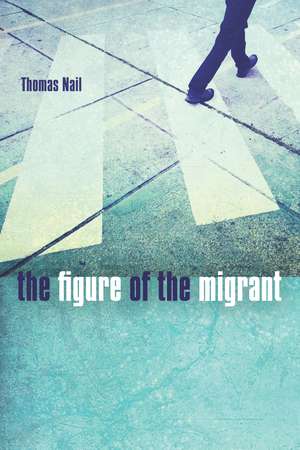The Figure of the Migrant
Autor Thomas Nailen Limba Engleză Paperback – 22 sep 2015
Rather than viewing migration as the exception to the rule of political fixity and citizenship, Thomas Nail reinterprets the history of political power from the perspective of the movement that defines the migrant in the first place. Applying his "kinopolitics" to several major historical conditions (territorial, political, juridical, and economic) and figures of migration (the nomad, the barbarian, the vagabond, and the proletariat), he provides fresh tools for the analysis of contemporary migration.
| Toate formatele și edițiile | Preț | Express |
|---|---|---|
| Paperback (1) | 174.65 lei 3-5 săpt. | +18.69 lei 4-10 zile |
| Stanford University Press – 22 sep 2015 | 174.65 lei 3-5 săpt. | +18.69 lei 4-10 zile |
| Hardback (1) | 649.11 lei 6-8 săpt. | |
| Stanford University Press – 22 sep 2015 | 649.11 lei 6-8 săpt. |
Preț: 174.65 lei
Nou
33.43€ • 36.32$ • 28.10£
Carte disponibilă
Livrare economică 31 martie-14 aprilie
Livrare express 14-20 martie pentru 28.68 lei
Specificații
ISBN-10: 0804796580
Pagini: 312
Dimensiuni: 152 x 229 x 23 mm
Greutate: 0.45 kg
Editura: Stanford University Press
Colecția Stanford University Press
Recenzii
Notă biografică
Descriere
Cuprins
The Introduction lays out the objectives of the book as a whole. Given the contemporary importance of migration, this book develops a political theory of the migrant. In particular, the aim is to overcome two problems: the migrant has been predominantly understood from the perspective of stasis and the state. If we want to develop a political theory of the migrant itself and not of the migrant as a failed citizen, we need to reinterpret the migrant first and foremost according to its own defining feature: its movement. This allows us to conceptualize the emergence of the historical conditions that give rise to the different types of social expulsion that define the migrant and to diagnose the capacity of the migrant to create an alternative to its social expulsion.
This chapter defines "the figure of the migrant" as a political concept that identifies the common points where mobile figures are socially expelled or dispossessed as a result, or as the cause, of their mobility. The movement of the migrant is thus not simply from A to B but the constitutive condition for the qualitative transformation of society as a whole. This chapter defines the migrant as a figure, which is not a fixed identity or specific person but a mobile social position. One becomes a figure when one occupies this position and may do so to different degrees, at different times, and in different circumstances. The figure of the migrant, for example, is like a social persona that bears many masks (the nomad, barbarian, vagabond, proletariat) depending on the relative social conditions of expulsion.
The history of the migrant is the history of social motion. This chapter defines and lays out the logical structure of social motion or "kinopolitics," the politics of movement. Instead of analyzing societies as primarily static, spatial, or temporal types of entities, kinopolitics or social kinetics understands them primarily as "regimes of motion." Societies are always in motion: directing people and objects, reproducing their social conditions (periodicity), and striving to expand their territorial, political, juridical, and economic power through diverse forms of expulsion. This chapter introduces three key concepts to understanding social motion: flow, junction, and circulation. In this way, it is possible to identify something like a political theory of movement. In particular, this chapter argues that the migrant is defined by two intertwined social motions: expansion and expulsion.
This chapter analyzes the first type of social expansion by expulsion: centripetal force. The first historically dominant type of expansion by expulsion can be described as a centripetal social force because its dominant motion is inward¿toward the creation of the first stable social centers on the earth's center-less surface. Since centripetal social force is primarily concerned with accumulation, territorial expulsion remains an indirect phenomenon. Nomads were not first expelled because they were foreigners or social inferiors. Rather, the type of expulsion proper to territorial kinopower creates a centripetal remainder: leftovers¿that which is not territorially accumulated. The figure of the nomad is simply expelled because there are not enough territorial flows left over for them, and they are in the way.
This chapter analyzes the second type of social expansion by expulsion: centrifugal force. This force emerges historically alongside the ancient empires of Mesopotamia, Egypt, Greece, and Rome. Political or centrifugal kinopower expands the curved movements of territorial control into a completely enclosed circle, brings all its stock into a shared resonance around a central axis, and radiates outward. It adds to the system of curved, centripetal expansion a system of concentric, centrifugal expansion and produces a new figure of the migrant: the barbarian. Territorial kinopower expands by creating a stock and expels only certain plants, animals, and people (nomads) as an indirect consequence: as an unaccumulated, aterritorial remainder.
This chapter analyzes the third type of social expansion by expulsion: tensional force. This force emerges historically alongside the feudal societies of medieval Europe. This type of kinopower is "juridical" in the kinetic sense in which law binds the movement of social beings to one another and to a certain social condition or territory. Tensional migratory expulsion occurs when these juridical linkages are severed and release a social flow: vagabondage. However, just as easily as this network of juridical linkages can be dissolved, so the links can be reassembled into new circuits. Internally, juridical kinopower expels peasants and debtors from their legal right to the land and expands legal power by criminalizing them as vagabonds. Externally, juridical kinopower expels foreign peoples through war, colonialism, and kidnapping and expands its legal power by colonial legislation: the encomienda.
This chapter analyzes the fourth type of social expansion by expulsion: elastic force. This type of kinopower comes to dominance during the sociohistorical period between the eighteenth and twentieth centuries and can be kinopolitically defined by the emergence of a newly dominant force of social motion: elasticity. This elastic force is a specifically "economic" type of kinopower in the sense that economics strives for the free arrangement and movement of things to and fro with a minimum of territorial, political, or juridical restrictions and with a maximum of equilibrium. The migrant proletariat is the spectrum of the proletariat that is economically expelled as a mobile social surplus. This chapter and the next analyze the specific social technologies of expulsion and mobilization that give rise to a variety of such migrant proletarian subjects and expand economic kinopower, including enclosures, capitalism, and eighteenth-century workhouses.
This chapter continues to analyzes the fourth type of social expansion by expulsion: elastic force. Not only is a migrant proletariat created through an intensive expulsion¿enclosures, capitalist valorization, and workhouses¿in order to increase competition and production, but it is also produced through an extensive expulsion via penal transportation, emigration, and denationalization. The chapter describes the forms of external expansion by expulsion in their intensive forms (the Atlantic slave trade) and their extensive forms (British colonialism in Ireland and North America).
The migrant has many different figures. The nomad, the barbarian, the vagabond, and the proletariat are only four major ones. Not only does each figure of the migrant emerge under different historical and social conditions of expansion and expulsion, but each figure also invents a form of kinetic power of its own that poses an alternative to social expulsion. Although each of the figures of the migrant deploys this force in its unique way, each is also the social expression of a more general "pedetic" social force. This chapter briefly outlines the concept of pedetic social force that is deployed by the four figures of the migrant analyzed in the following chapters of Part 3.
This chapter analyzes the first figure of pedetic social force: the nomad. The nomad is not simply the result of a primary territorial, centripetal expulsion. Early hunter-gathers were not simply left out from territorial society; they also actively left it and invented an entirely different form of social motion. Hunter-gathers moved to the mountains and cultivated the newly discovered art of animal raising. In cultivating this art so exclusively, they had to invent a form of social motion most conducive to it. Nomadism oscillates continually by following the earth's flows wherever they may go, without centripetal capture or accumulation. Nomadism also deploys a transportation of social kinetic disturbances: waves. The nomads' kinetic wave is a mass or common phenomenon that links them by force without producing a division in their motion. Finally, nomadism creates a social pressure against territorial barriers.
This chapter analyzes the second figure of pedetic social force: the barbarian. The barbarian, like the nomad, is not merely the result of a kinetic expulsion. Barbarians also invent their own form of social motion that functions in a pedetic way. Just as "barbarian" in the ancient world was often etymologically or literally the word for the "slave by nature," it is not surprising that the ancient art of pedesis appears most predominantly in the oscillations, waves, and social pressures of refugees and slave revolts.
This chapter analyzes the third figure of pedetic social force: the vagabond. The vagabond is not only the criminalized migrant expelled by the tensional force of law as the tramp, the debtor, the beggar, the pauper, the vagrant, the heretic, the witch, the Jew, the minstrel, the foreigner, the homeless. The vagabond, from the Latin vagus, meaning "to wander," from the Latin proprius, meaning "one's own way," is also the migrant whose free wandering has its own techniques of pedetic force found in the kinetic counterpower of rebellion: the direct battle with the forces of expulsion.
This chapter analyzes the fourth figure of pedetic social force: the proletariat. The proletariat is not only a migratory surplus expelled by the elastic force of the economy; the proletariat also breaks free from the driving forces of oscillation (profit, equilibrium, competition, etc.). In other words, the proletariat responds to elastic force with a pedetic force of its own. This pedetic force is defined by the free oscillation of social movements, the wave of protests, communes, and the pressure of the strike in its various forms: the barricade, the labor strike, the hunger strike, the boycott, and others.
The aim of the final part of this book is to deploy a hybrid theory of kinopolitical analysis to the increasingly complex phenomenon of contemporary migration. The history of the migrant this book has traced so far is not simply a history of the past; it is also a history of the present in which all of the historical conditions and figures of the migrant return and mix. This chapter describes the reemergence of centripetal social force seen in contemporary Mexico-US migration. While unquestionably mixed with several other types of social motion, centripetal force in its most basic form remains a crucial condition for the expulsion of the Mexican people and the expansion of US and private power. Today, we call this "land grabbing." This chapter describes two major periods of centripetal accumulation in Mexico: the Porfiriato and neoliberalism.
This chapter analyzes the use of centrifugal social force in Mexico-US migration. There are several ways centrifugal power operates through federal power in Mexico and the United States to expand its reach and expel migrants. The centrifugal force of the Mexican state expands its centralized force by the direct expulsion of indigenous farmers from public lands and the reappropriation of their labor by other means. It also uses direct police and military violence to expel migrants. When peasants will not migrate or sell their land "voluntarily" to these state-sponsored mega-projects, a centrally directed police and military force is sent out from the city to directly expel people from the territory. Finally, Mexico and the United States treat migrants as naturally inferior and depoliticized barbarians.
This chapter analyzes the use of tensional social force in Mexico-US migration. Contemporary tensional force is created by the rise of multiple legal powers: international, supranational, humanitarian, and corporate law that now poses entirely new limitations on the executive power of sovereign governments. Today's tensional forces that bind social motions, although no longer feudal, still take the form of a vast network of legal contracts binding at every level of society, that is, between individuals, local law, states, nations, and other non-state international organizations. This is accomplished in several ways: the reform of the countryside in Mexico, the North American Free Trade Agreement, Free Trade Zones and maquiladoras, the criminalization of labor in the United States, and the detention and expulsion of migrants in the United States.
This chapter analyzes the use of elastic social force in Mexico-US migration. Elastic force expands and expels not by creating and breaking juridical tensions between social motions but by creating and redistributing a surplus of motion elsewhere. As long as a society is capable of producing and mobilizing its surplus and deficits, it will be able to pursue equilibrium and hopefully expand. Thus, elasticity expands and expels, not from the outside to the center (centripetally), nor from the center to the outside (centrifugally), nor by rigid links between centers (tension), but rather by the redistribution of a surplus wherever it is needed. This accomplished in several ways: the redistribution of surplus in Mexico, privatization, guest-worker programs, and undocumented migrant workers.
This chapter analyzes four types of contemporary migrant counterpower in the case of Mexico-US migration. Just as contemporary migration is produced by the forces of social expansion and expulsion, so it is also defined by the pedetic counterforces of oscillation, waves, and pressure. Social pedesis is the irregular movement of a collective body: a social turbulence. It is the force of motion of the social figure who moves outside the dominant forms of social motion: the migrant. This is expressed in four contemporary figures of Mexico-US migration: the nomadic seasonal worker, the barbarian invader, the vagabond rebel, and the proletarian occupier.
The Conclusion recapitulates the main problems and consequences of the movement-oriented theory of the migrant presented throughout the book. Additionally, it highlights three major areas where further work is necessary. First, future work is necessary to analyze the kinopolitical technologies presented in this book (and others) according to their full historical and kinetic mixture or hybridization¿which this book has presented only in their relative isolation. Second, many other major and interesting areas of contemporary migration remain to be analyzed with this framework, such as the landless peasant movement in Brazil, the recent home foreclosure process happening around the world, the recent land grabs and expulsions in Cambodia, and the sans-papiers (without papers) struggle in France. Third, future work is needed to examine additional figures of the migrant, such as tourists, commuters, diplomats, and business travelers, with respect to their degrees of expulsion and movement.




















